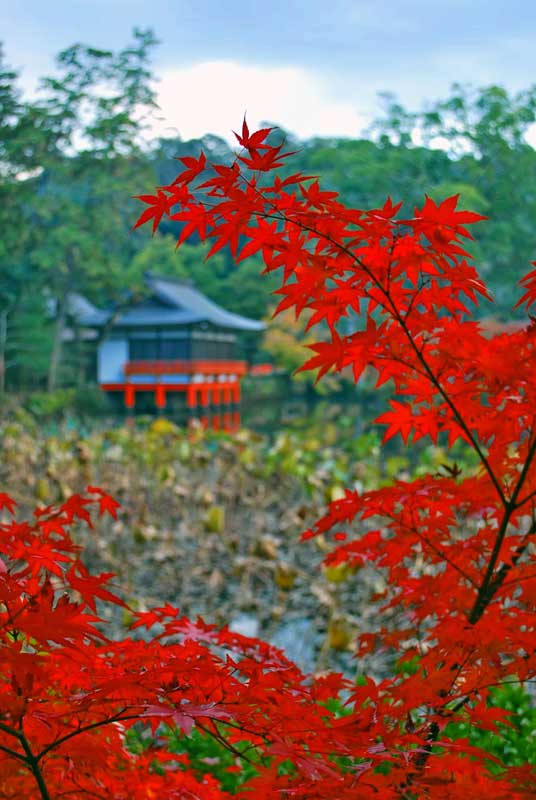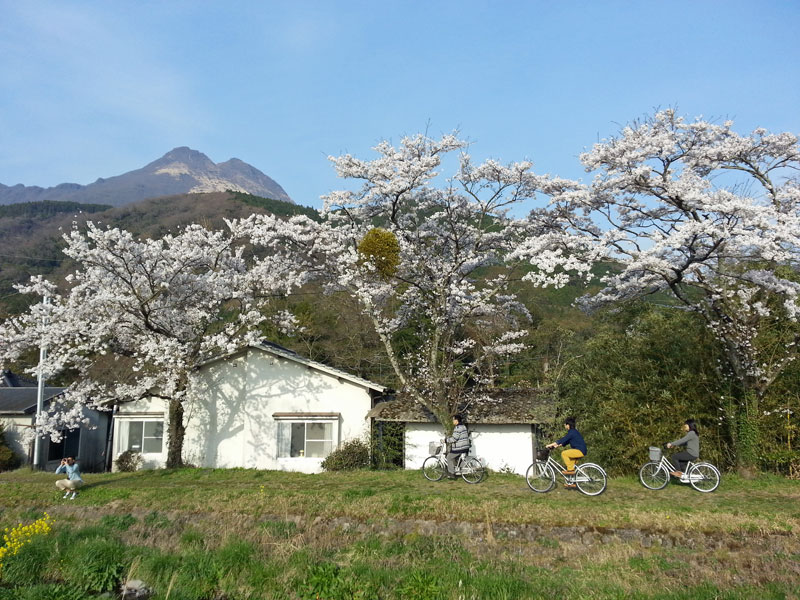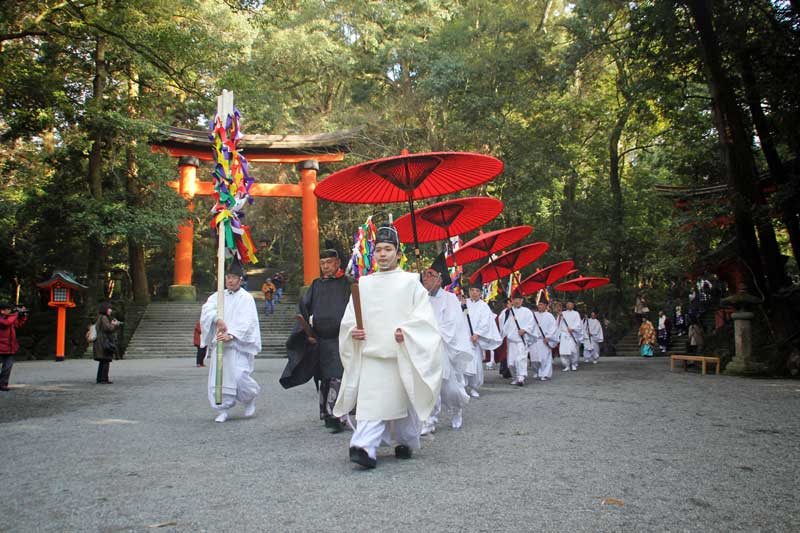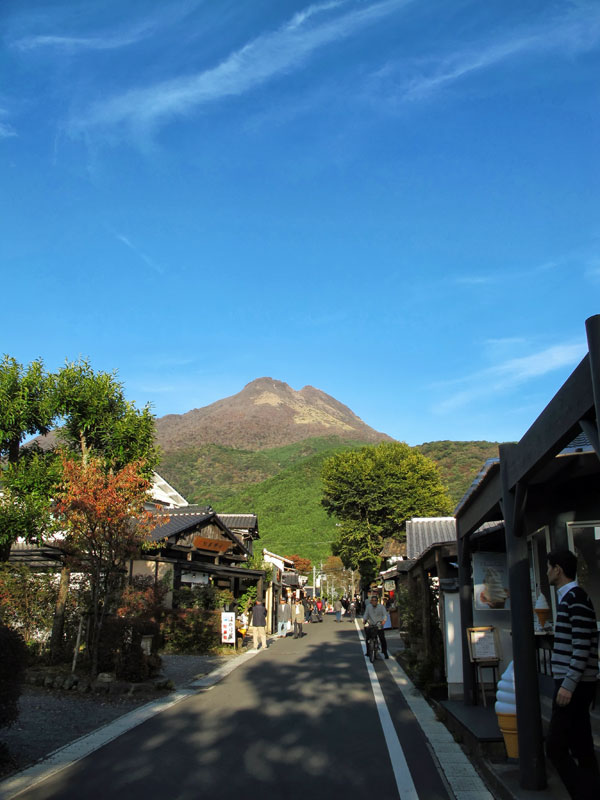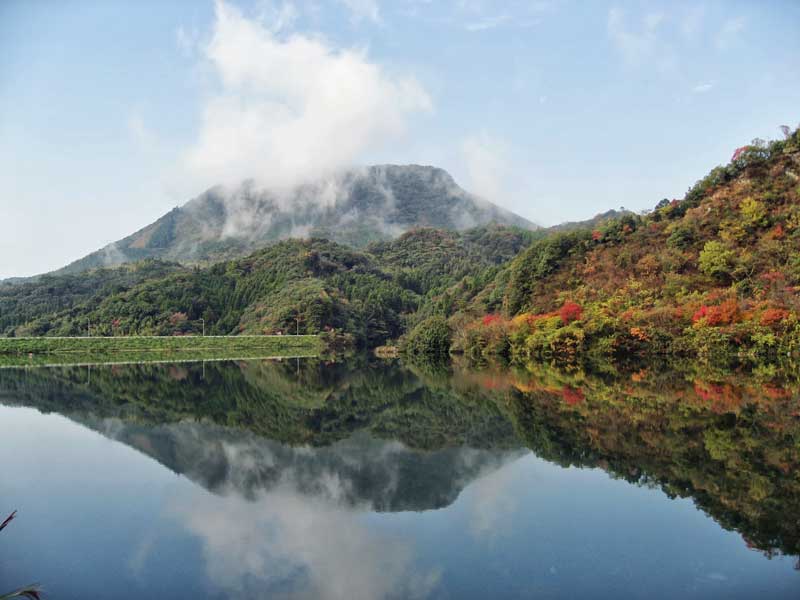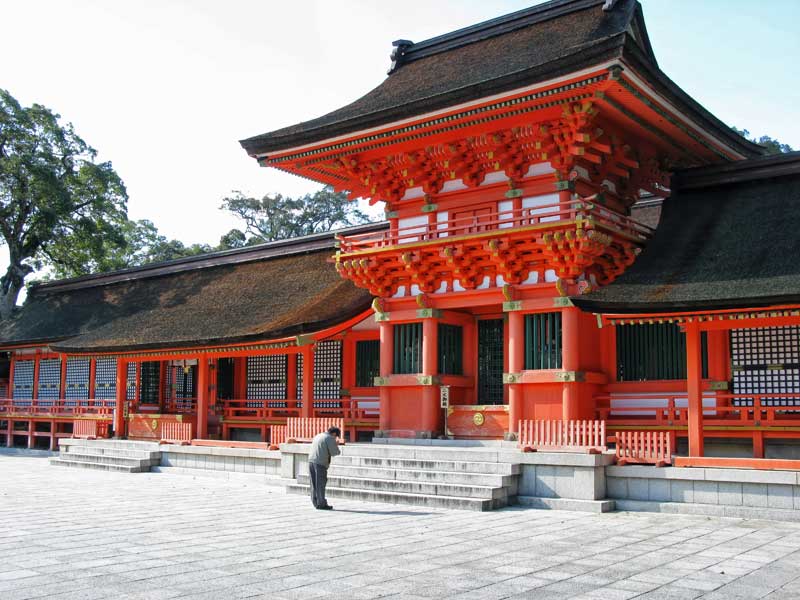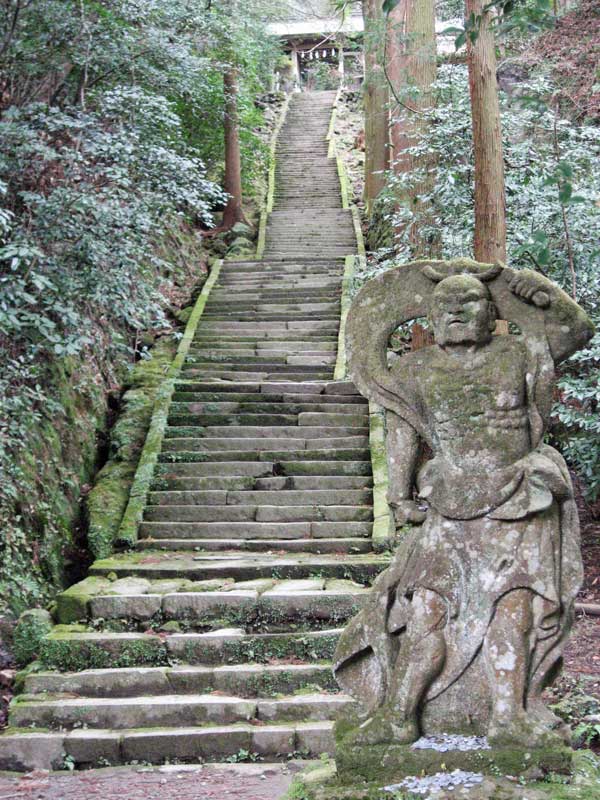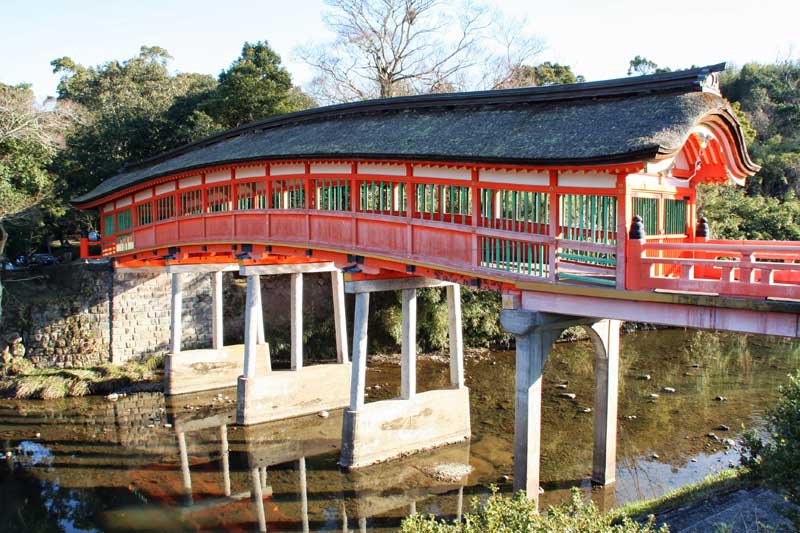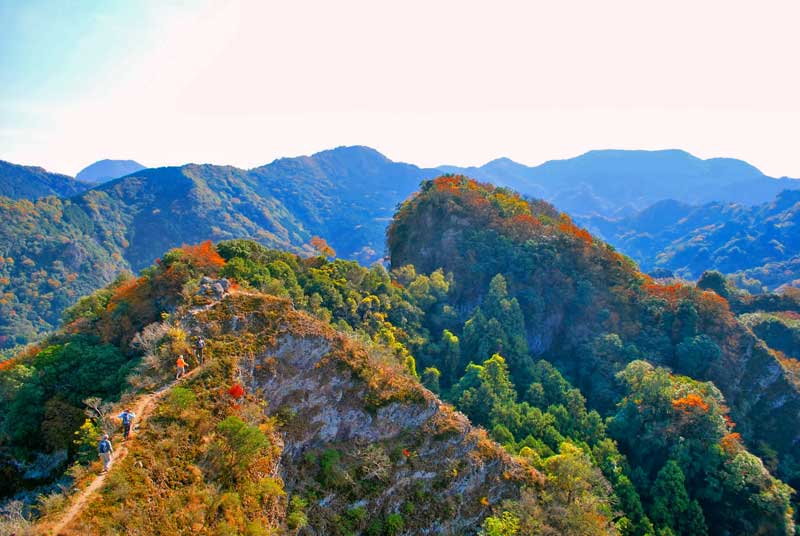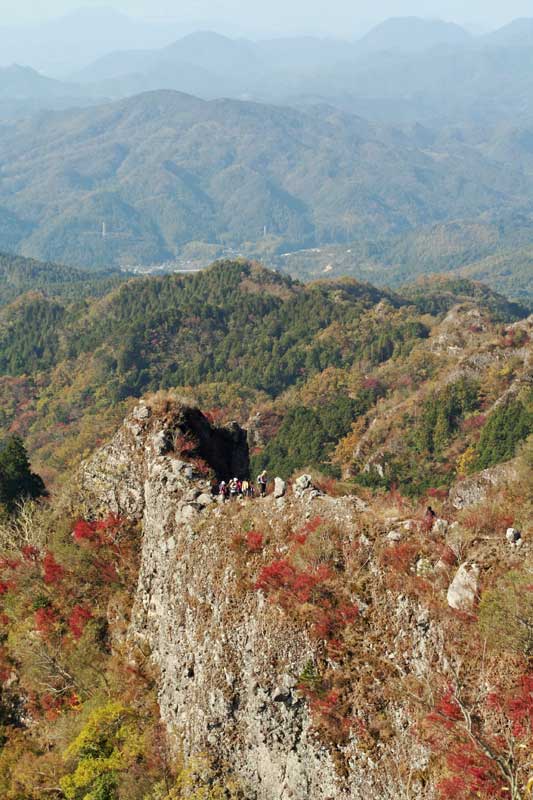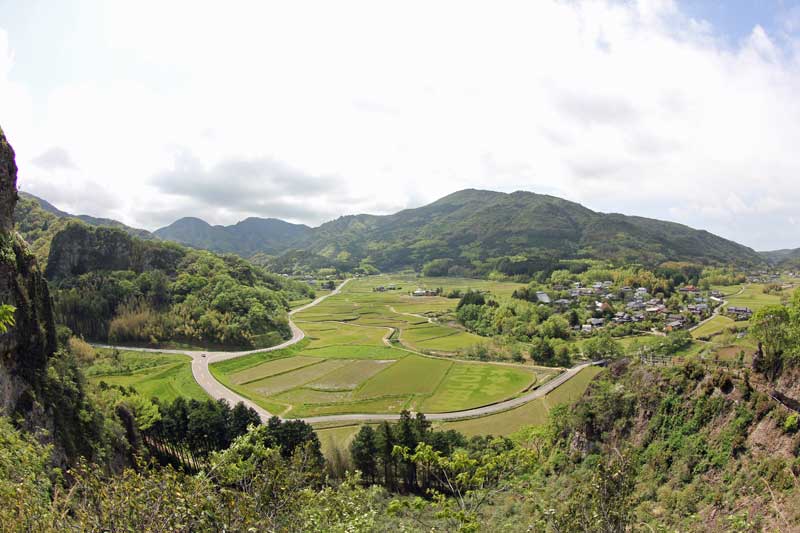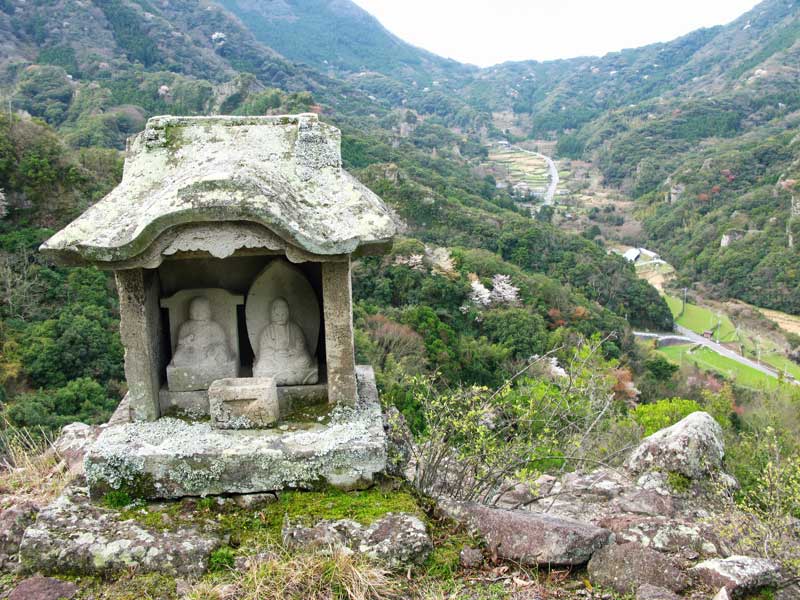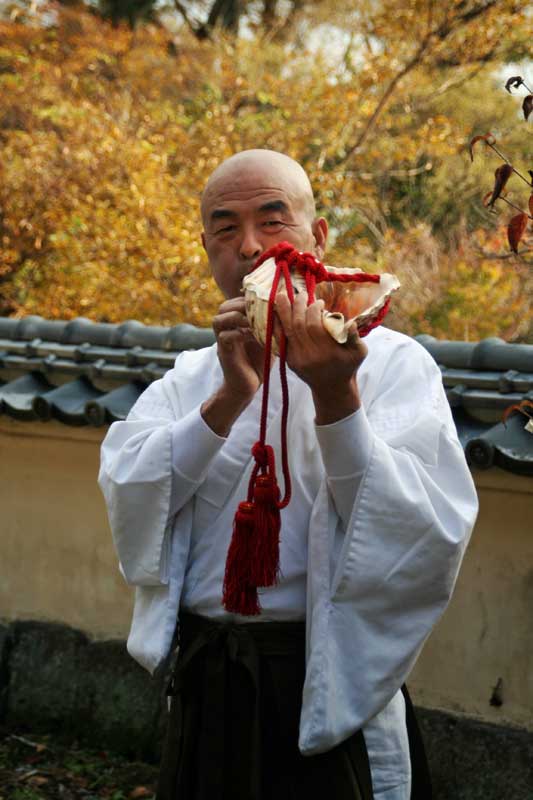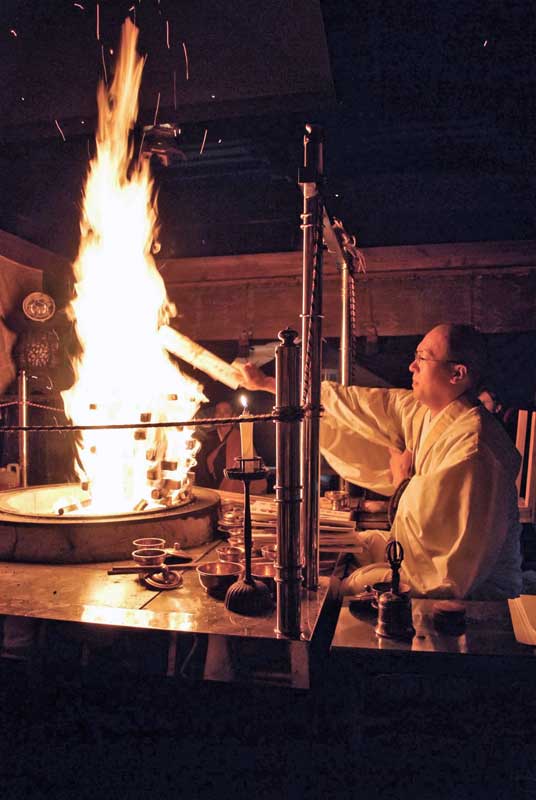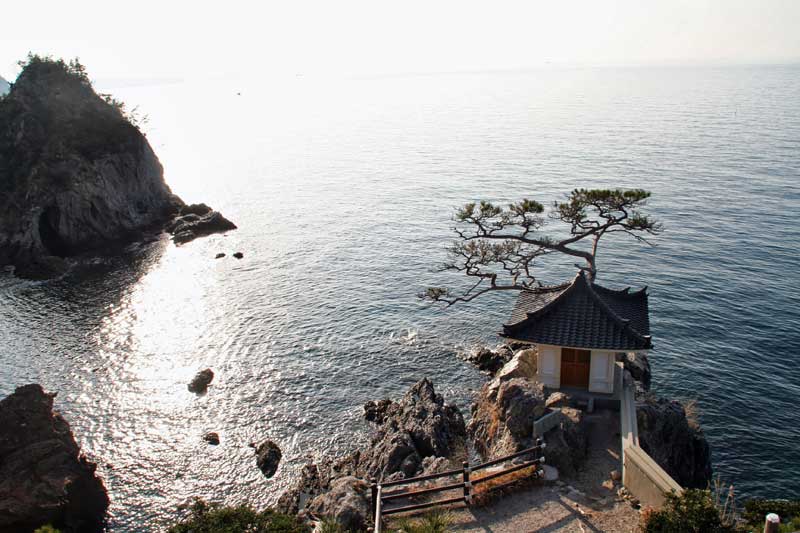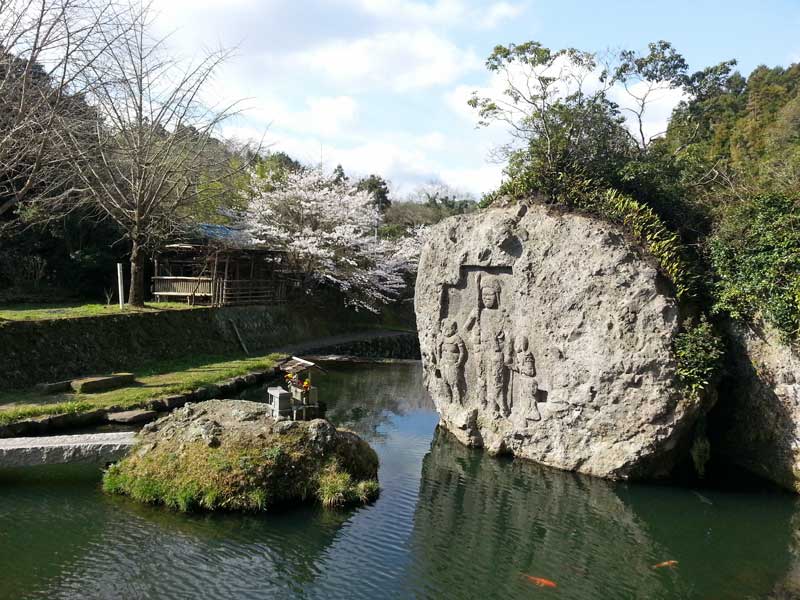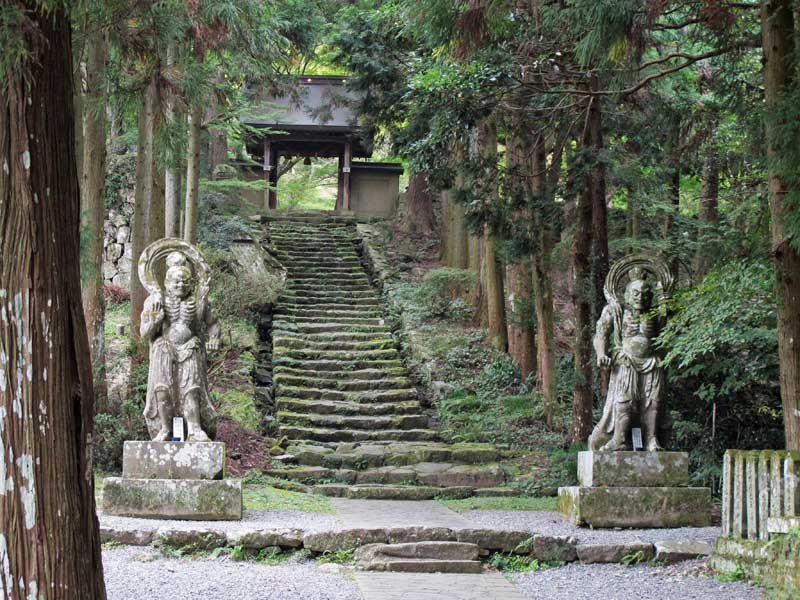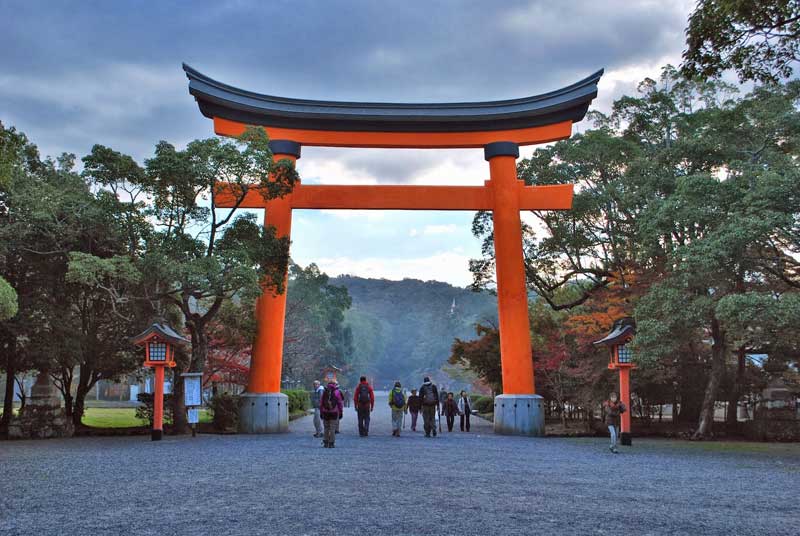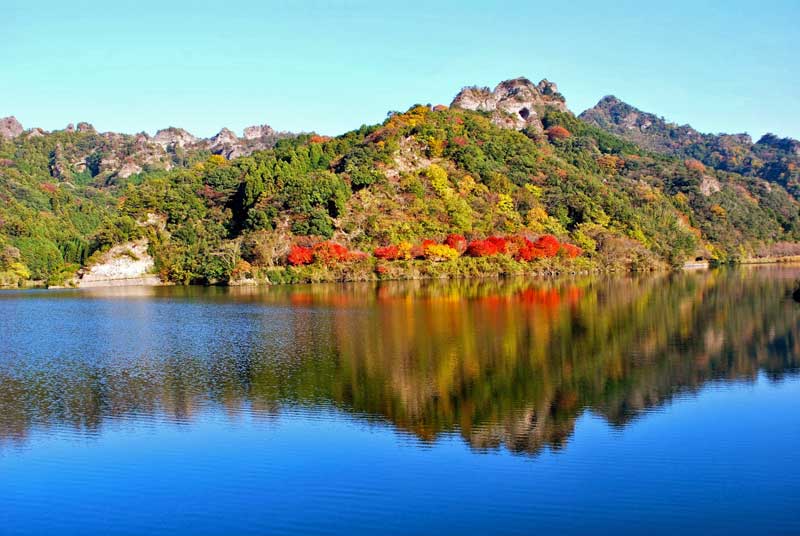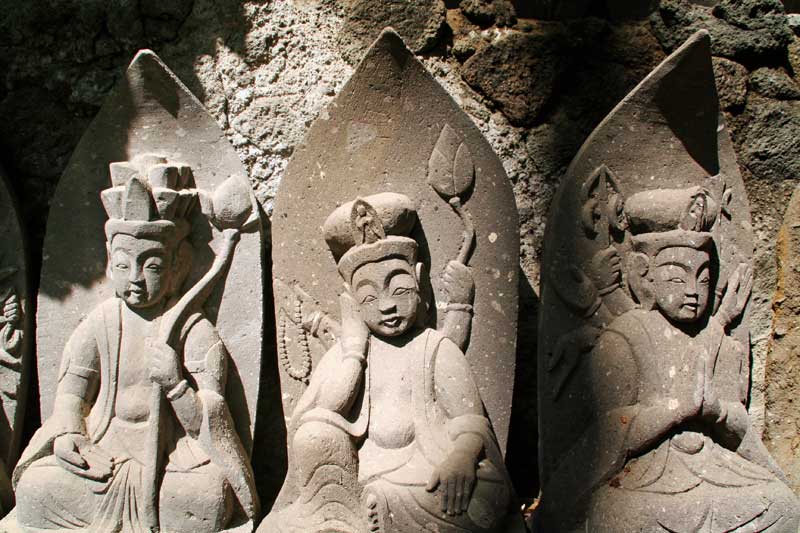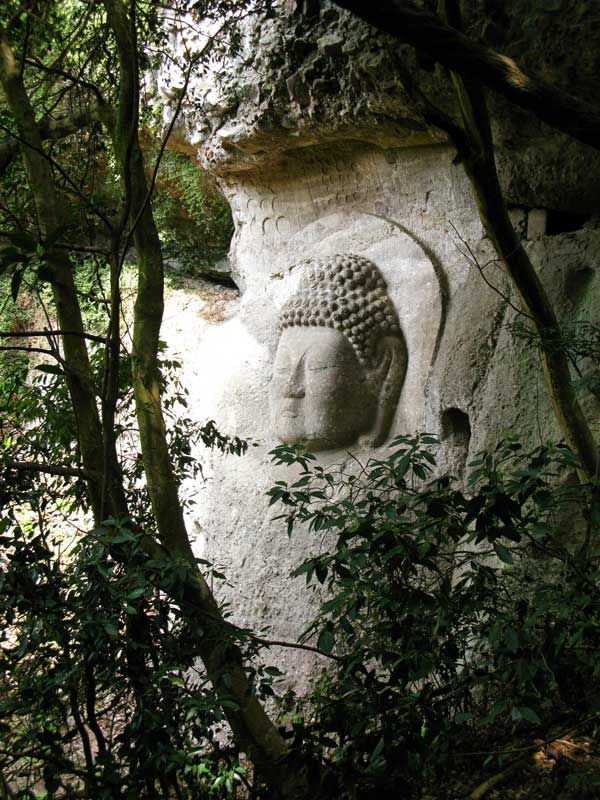A walking tour following paths once trod by monks in Kyushu.
Guided exploration of the Kunisaki Peninsula, one of Japan's hidden gems; excellent walks along ridge trails once used by Buddhists monks in meditation in beautiful and remote countryside; atmospheric inns, ample and delicious cuisine, onsen thermal hot spring baths.
March - June & September - November.
A 10-day, 9-night tour starting in Nakatsu and finishing in Yufuin. Accommodation is in Japanese inns, many with onsen thermal hot spring baths, a temple and a hotel. Please read more on accommodation here. The small intimate nature of the inns makes the maximum group size 12 people. We have no minimum size. If we accept a booking we guarantee to run the tour.
Walk Japan’s Kunisaki Trek follows in the footsteps of monks, who have walked the mountains of the Kunisaki Peninsula for more than a thousand years. Any experienced trekker will thoroughly enjoy the ancient trails, now largely forgotten. These provide excellent walking through sleepy hamlets and verdant forests, along craggy ridges and over towering cliffs. On route we pass many stone Buddha statues, large and small, and the caves where monks once found shelter. As with all our tours, on Kunisaki you will be immersed in Japanese culture of the past and present, enjoy Japanese cooking at its best, luxuriate in hot springs and simply gaze at the beautiful scenery. This, of course, is all with the expert guidance of your Walk Japan tour leader.
The Kunisaki Peninsula is nestled into the western end of Japan's Seto Inland Sea on Kyushu, the most westerly island of the Japanese archipelago. But the peninsula may as well have fallen off the map, for few Japanese and even fewer foreigners know of its existence. Modern Japan has left this quiet haven of rural life largely untouched. It was, though, for many centuries an important centre of Shugendo. Shugendo is a syncretism of the indigenous, animistic Shinto religion and Buddhism brought from China and Korea. Kunisaki's once-powerful religious institutions are long gone, but delightful temples and wayside shrines are some reminders of its deeply religious past.
Mine-iri, a monk's practice of traversing sacred mountain paths in prayer, has been part of the religious life of Kunisaki since the ninth century. Although now rare, the practice still continues today in Kunisaki, one of only a few places in Japan where it still does so. Our trek follows in the monks’ footsteps. Occasionally we pass through picturesque hamlets and temple grounds, but otherwise our trek is largely off-road on little-known mountain paths. The climbs are usually short but they can be steep and require a degree of stamina to reach the peaks. Once there, the rewards include tremendous views and heady thrills as we negotiate narrow ridges and bridges. A reasonable head for heights is necessary.
Just to the south-east of Kunisaki is Yufuin, a small, upmarket town in the shelter of the towering Mount Yufudake, an extinct volcano. Many of Japan's top writers have found, and still find, a haven here to put pen to paper. Perhaps because of this, along with the many onsen hot springs found here, the town boasts some of the finest ryokan inns that Japan offers. Yufuin is also ideal for browsing and shopping. We spend two nights here, interspersed with an ascent of Mount Yufudake. Lunch at the top of this mountain is enjoyed with a backdrop of grandstand views over Kunisaki and beyond.
The Kunisaki Trek tour includes some high, narrow ridge trails and short climbs requiring the use of fixed chains. It is recommended for fit individuals who are comfortable with heights. Please contact us for guidance if you are not sure whether this tour is suitable for you.

Day 1 Nakatsu – Yabakei
The tour group meets at 3:15pm at Nakatsu Station in Oita Prefecture.
From Nakatsu we travel 30 minutes by private-hire vehicle to Yabakei, where we stay the night in the surroundings of a delightful onsen thermal hot spring accommodation. Yabakei is known for its picturesque valleys, verdant forests, sparkling streams and, of course, its many onsen.
After checking in we have time to immerse ourselves in the onsen baths. Refreshed, we enjoy a sumptuous welcoming banquet.
Accommodation: Modern Japanese inn with onsen hot spring baths.
Meals: Dinner provided.
Total walking: N/A.
Total elevation gain: N/A.
Day 2 Yabakei – Fuki-ji
After breakfast our main luggage is taken on to our evening’s accommodation. All we need to take with us is what we need for our walk today. A short transfer brings us to the start of our first walk and a climb of Kumo-ga-take (654m/2,145ft), or Cloud Mountain. On a cloudy day, our climb leads us up through mists through which we catch sight of the first of many ancient Buddhist statues that are a vivid indication of the rich history of Kunisaki. On a clear day, the views afforded across the verdant valleys and mountains of Kunisaki and the rest of Kyushu can only raise expectations of our trek on the Kunisaki Peninsula.
After our climb of Kumo-ga-take a short path leads to the neighbouring peak of Omoto-san (647m/2,123ft), one of the most sacred mountains in Kyushu. Omoto-san is the oku-no-in, the remoter interior shrine, of Usa Jingu, one of the least known but most important shinto shrines in Japan. A simple, rustic shrine building on Omoto-san’s peak is in startling contrast to the scale and opulence of Usa Jingu, which is far below us on a farming plain at the foot of the mountain. N.B. Usa is pronounced Oosa.
Our path down follows the route that the shrine priests used over the ages. However, these days the priests make the trip by car and few others walk this way any more. Our descent, largely through forests following rough trails and quiet country lanes, brings us to the end of our day's walking at the grand and atmospheric Usa Jingu. The shrine is one of the most important but least known of the great shrines of Japan. The shrine deifies the protector god of Japan, Hachiman It is also where Kunisaki’s history as a centre of Buddhism has its origins.
However, before we spend time strolling around the extensive grounds of the Usa Jingu we take time to enjoy a late lunch. This is at a nearby restaurant specialising in dango-jiru, a delicious, local delicacy of thick, wheat noodles in a vegetable broth.
We return by vehicle to our accommodation for the coming two nights. Set in a delightful rural, hamlet, our inn is adjacent to Fuki-ji, a temple that includes one of the simplest and most beautiful Buddhist structures in Japan. Our inn also has onsen thermal hot spring baths, which we enjoy throughout the tour. The onsen here, as anywhere else, is a great way to relax after our exertions of the day. Dinner, a feast of locally caught fish and locally grown farm produce, follows and is taken in our inn.
Accommodation: Modern Japanese inn.
Meals: Breakfast, lunch & dinner provided.
Total walking: 11 km (6.8 miles) / 5 hours.
Total elevation gain: 430m (1,410ft).
Day 3 Fuki-ji – Tashibu – Fuki-ji
After a traditional Japanese breakfast, we visit the neighbouring Fuki-ji temple. Although one of the treasures of Kunisaki and relatively well-known few, if any, other visitors will be there and we likely have the place to ourselves.
Another short transfer to Makiodo. Although a rather basic temple building, Makiodo has become a treasure house of Buddhist relics saved from a powerful temple here that fell into ruin in the Kamakura Period (1185-1333). Makiodo is also the beginning of today’s walk, which has little climbing and takes us through Tashibu-no-sho, a charming village with some of the most picturesque countryside found in Japan. As we stroll, we come across stone and wooden Buddhist statues perched in caves overlooking farmland scenery that seems to have changed little since Kunisaki was chosen as a Buddhist centre some 1200 years ago.
We enjoy lunch en route at a charming, local restaurant specialising in organic, local dishes. From here, our winding path takes us through forests, over a low mountain ridge, along the edges of paddy fields and past the carefully tended gardens of the local farm houses before we eventually end up again back at our accommodation at Fuki-ji.
Accommodation: Modern Japanese inn.
Meals: Breakfast, lunch & dinner provided.
Total walking: 9 km (5.6 miles) / 4.5 hours.
Total elevation gain: 320m (1,050ft).
Day 4 Fuki-ji – Matama
After breakfast, our minibus takes us and our luggage on a 30 minute journey to Coton-mura, a lakeside park, where we begin our trek over which are beautiful views to a rugged ridge. Our main luggage will be taken on by the minibus to our accommodation for the evening. On our way to Coton-mura we follow a valley along quiet roads and through beautiful little hamlets. The scenery becomes very rural and we begin to see the mountains we will soon be trekking through. Carrying only what we need for the day’s walking we set off on our trek, which in large part is little known and even less walked these days.
After about a kilometre (0.6 miles) of walking on a quiet road we join a forest track. The track sets the tone for nearly all our walking on the tour. Our path first takes us down the front of the dam holding back the lake and through a quiet hamlet. Look out for the impressive stone wall on our right as we pass through the hamlet. We then climb up and around the side of Yayama, an imposing tent- shaped mountain, passing by long disused stepped fields, the last of which have recently been planted out with hinoki (chamaecyparis obtuse, Japanese cypress), sugi (cryptomeria japonica, Japanese cedar) and kunugi, (quercus acutissima, sawtooth oak/Chinese cork oak). Look out for circular depressions surrounded by stone walls; these were once kilns. Originally they had a mud roof and would have been used to turn kunugi, konara (quercus serrata, konara oak), and kashi (quercus myrsinaefolia, Japanese white oak) into charcoal. Charcoal was extensively used for heating in hibachi, a portable brazier, and irori, fireplace, and also for cooking. Charcoal burning is still undertaken on a small scale in Kunisaki during the winter months.
As we circuit Yayama we arrive at Choan-ji. This temple is known for its gardens that seem to retain their colour throughout the year. We will take a rest here for a short while before resuming our trek. Our path from here is down a steep concreted slope. Beware, this is always slippery, all the more so when the weather is inclement. The path takes us to Kawanaka-Fudo and Tennen-ji. En route look out across the valley for Mumyo-bashi, a stone bridge lodged precariously between two cliff faces. Tennen-ji is one of only three temples these days where Kunisaki’s most impressive and ancient festival, Shujo-Onie, now takes place. Fire, dancing and ‘devils’ are the hallmarks of this rite that goes back 1,000 years. We will see devil masks on our route once used in the festivals. We will also see replicas, large and small, for purchase. Unfortunately for us, Shujo-Onie takes place on the lunar new year at the beginning of February.
Our trail this afternoon includes a short but stiff climb, in part with fixed chains to assist us on our way up and over a ridge. A cliff-hugging descent brings us down to a country lane and our last temple for the day. A 45-minute walk from here aside this quiet road brings us to our accommodation and another well-deserved thermal hot spring bath for the night. We enjoy our evening meal, another feast of local produce, together in our accommodation.
Accommodation: Japanese-style hotel with onsen hot spring baths.
Meals: Breakfast, lunch & dinner provided.
Total walking: 11 km (6.8 miles) / 5.5 hours.
Total elevation gain: 510m (1,670ft).
Day 5 Matama – Himeshima
Our main luggage is sent on by taxi while we travel by minibus a short distance to the beginning of Nakayama Senkyo (317m/1,040ft), a ridge walk with spectacular views. The ridge is also the route of an ‘88 stations’ pilgrimage created for locals who could not make the journey to Shikoku for the 88 temples pilgrimage. We take a break on the ridge with a small buddha statue for company. From here 360 degree views stretch over picturesque valleys, sparsely dotted with the occasional house, to the Seto Inland Sea. The path beyond here dramatically narrows at a couple of points requiring some extra care before we reach a section with chains that help us on our way down to the next valley. Our bento lunch boxes will be delivered to us at a small, rural shrine in the valley bottom. We then take a taxi to Imi, a small port on Kunisaki’s north coast. After picking up our luggage we catch the ferry across to Himeshima, a delightful island off the peninsula’s north coast.
The ferry journey is twenty minutes across the Seto Inland Sea and our accommodation, an elegant old inn, is a five minute walk from the wharf. We, however, first set for a circular walk of Himeshima that includes a climb of Mt. Yahazu-dake (267m /875ft).
Dinner at our inn is another feast focused on seafood caught from the surrounding sea.
Accommodation: Traditional Japanese inn.
Meals: Breakfast, lunch & dinner provided.
Total walking: 8 km (5 miles) / 5 hours.
Total elevation gain: 530m (1,740ft).
Day 6 Himeshima – Iwato-ji
After an early breakfast, time for a guided exploration of the island’s main settlement, a cosy place where the locals of all ages are exceptionally friendly. Our walk takes us to Sennin-do, a shrine set in a classic fashion at the end of a small, precipitous peninsular overlooking the sea. However, we cannot dawdle here too long as we have to be on the mid-morning ferry back to Imi and Kunisaki. Our main luggage will be waiting for us to collect before crossing the gangway onto the ferry.
On arrival, our main luggage disappears into another vehicle and then we head off to a nearby pleasant local art gallery-cum restaurant. The building, once one of the most opulent in town, has been sympathetically renovated and is interesting in its own right. There are a variety of gifts on display to peruse and buy, if one wishes. We enjoy lunch here before a short transfer by vehicle to the start of our afternoon walk.
Today’s trek takes us through the extensive grounds of Kyu Sento-ji, a once powerful temple. Two impressive Nio guardian deities, myriad gravestones, ancient stone walls and foundations are all that remain today. Climbing past some stone Buddha busts created recently by local sculptors we once again see Itsutsu-ji Fudo towering above us. Another short, steep climb brings us out at the ‘fortress rock’ peak of Mt. Fudo-san (352m/1,155ft), which houses in its shadow a small temple, Itsutsu-ji. This marks the furthest extent of Kyu-Sento-ji’s grounds. From here panoramic views across Kunisaki to Hime-shima and beyond to Yamaguchi Prefecture on Honshu are a fitting reward for the climb up here. We now follow a hidden forest path to Iwato-ji, yet another rustic temple of the Kunisaki Peninsula.
From here we transfer to our accommodation for the next two nights, Baien-no-Sato. Named after Miura Baien, a local who excelled in philosophy and sciences in the 18th century, this modern inn has an unusual addition in his honour; a large 65cm reflecting telescope. Baien, who was born close by and lived most of his life in the vicinity, studied rangaku, western sciences, western philosophy and astronomy.
Once again the baths help wash away the day’s exertions readying us for dinner.
Accommodation: Japanese-style hotel with onsen hot spring baths.
Meals: Breakfast, lunch & dinner provided.
Total walking: 9 km (5.6 miles) / 5 hours.
Total elevation gain: 430m (1,410ft).
Day 7 Monjusen-ji – Baien-no-Sato
After breakfast, a vehicle transfer brings us to the start of our walk today, an ancient flight of stone stairs to Monjusen-ji, a temple built in front of a cave. This feature is found at some of Kunisaki’s oldest temples as ascetic monks used to use caves for shelter and prayer when Buddhism first reached the peninsula.
Monjusen-ji is perched on the side of a cliff that towers over the temple. The rising sun provides yet more spectacular views. We climb up away from the temple. If the monk is in residence the sound of a conch horn, an indispensable item of a yamabushi (mountain ascetic) monk, will send us on our way. As we continue up we begin to follow a rocky outcrop. This was once a lava ‘vein’ deep inside a long gone volcano that funnelled molten lava to a crater. The rocky outcrop provides more panoramic views north across Kunisaki to the Seto Inland Sea and Honshu, Japan’s main island.
The walk continues gently on, undulating as the path winds through plantation forests. We take a break at a small, lonely temple, which narrowly missed being crushed by a falling cedar tree some years ago. From here we skirt around Mt. Futago on old roads back to Futago-ji. Here we pause at the bottom of some long stone steps guarded by two Nio deities for a group photograph. Further up the steps in a small hut is a large relief model of the Kunisaki Peninsula. Your tour leader will trace the route completed to this point.
We eat our lunch in a hut on the grounds of Futago-ji before having a look around. If he is in residence, the young priest will join us and introduce us to some of his temple’s extensive grounds. From here we return by dedicated vehicle to Baien-no-Sato where hot baths and another delicious evening meal await.
Accommodation: Japanese-style hotel with onsen hot spring baths.
Meals: Breakfast, lunch & dinner provided.
Total walking: 7 km (4.4 miles) / 4 hours.
Total elevation gain: 460m (1,510ft).
Day 8 Baien-no-Sato – Yufuin
After breakfast our minibus arrives. We will take our luggage with us in the vehicle until we reach our evening’s accommodation in Yufuin. Before our walk we first visit Koumori-tei, Walk Japan’s local office and centre piece of our community project. We will take some time to wander the project site, and learn about how it is helping to put some vigor back into the area which, like many other rural regions of Japan, has suffered a sharp decline in population.
From Koumori-tei, it is a short drive to the start point of our climb up to Mt. Nokogiriyama (542m/1,778ft), the border between Kunisaki and the rest of Kyushu. This is followed by a spectacular two and a half hour ridge walk. Nokogiri-yama looms above us as we start our 30 minute ascent. We climb up through a forest that suddenly opens up onto a ridge, towering over the surrounding landscape. No great exertion is required now for the rest of the day’s walk. Particular care, though, is required on the sometimes precipitous path, but the reward is magnificent and offers heady views across both Kunisaki and Kyushu. Lunch is another bento box which we eat, weather permitting, while viewing the spectacular scenery. Our descent takes us past the giant Kumano Magai-butsu- Dainichi Nyorai and Fudo Myo-o - carved in relief on a towering cliff face. Thought to date from the earliest days of buddhism on Kunisaki, these twins are a spectacular finalé to our walk today. A flight of rocky steps, which legend relates was built by a devil over one night and is certainly devilish to negotiate, brings us down to a small shop serving cold drinks and hot coffee.
After an hour’s drive we arrive at our ryokan in Yufuin. Yufuin is known for its thermal hot springs and our ryokan has its own. Here we can relax before dinner.
Accommodation: Modern Japanese inn with onsen hot spring baths.
Meals: Breakfast, lunch & dinner provided.
Total walking: 7.5 km (4.7 miles) / 4.5 hours.
Total elevation gain: 370m (1,210ft).
Day 9 Yufuin – Mt. Yufu-dake – Yufuin
Breakfast is followed by a quick visit to a nearby 24-hour shop to purchase picnic lunches. We will take these with us to eat at the top of Mt. Yufudake (1,583m or 5,193ft). Please also take with you some extra, warm clothing - hats, windproof jacket, gloves, etc. - as it is likely to be cold at the top.
We transfer to the start of our climb at an altitude of 750m (2,460ft). We will reach the top in about 2 hours 30 minutes. A leisurely lunch can be enjoyed at the top with views over Kunisaki, Beppu Bay and Yufuin. We then descend to Yufuin and back to our accommodation and the very welcome thermal hot spring bath. A celebratory dinner follows to mark the last night of our tour.
For those who would like a more leisurely time today, Yufuin with its many galleries, cafés, shops and restaurants is a pleasant place to relax in on one’s own whilst the others climb Mt. Yufu.
Accommodation: Modern Japanese inn with onsen hot spring baths.
Meals: Breakfast & dinner provided.
Total walking: 9 km (5.6 miles) / 6 hours.
Total elevation gain: 800m (2,620ft).
Day 10 Yufuin
The tour finishes after breakfast, and return travel to Fukuoka can be made by train or highway bus. Your tour leader is available to assist with post-tour travel arrangements.
Accommodation: N/A.
Meals: Breakfast provided.
Total walking: N/A.
Total elevation gain: N/A.
This itinerary is subject to change.
The airports closest to the tour’s start at Nakatsu station are Fukuoka International Airport and Oita Airport, with domestic flights departing frequently from Tokyo and Osaka’s airports.
-----
BY AIR
-----
FROM FUKUOKA INTERNATIONAL AIRPORT (FUK)
From Fukuoka International Airport, take the City Subway line to Hakata Station, which takes approximately 5 minutes. Alternatively, the journey by taxi takes approximately 15 minutes. From Hakata Station follow the travel by rail instructions below.
FROM OITA AIRPORT (OIT)
From Oita Airport, travel to Nakatsu either by taxi, or by bus. Please note that the latter runs only four times each day.
-----
BY RAIL
-----
FROM HAKATA STATION
Travel by the JR Sonic Express train to Nakatsu Station. The journey takes approximately 1 hour and 20 minutes.
FROM KOKURA STATION
Travel by the JR Sonic Express train to Nakatsu Station. The journey takes approximately 30 minutes.
The pre-tour pack includes detailed instructions, including a map, for travel to the accommodation at the start of the tour.
Tour participants are strongly advised not to book themselves out on a morning flight at the end of the tour, as the journey from Yufuin to the nearest international airport is approximately 2 hours.


